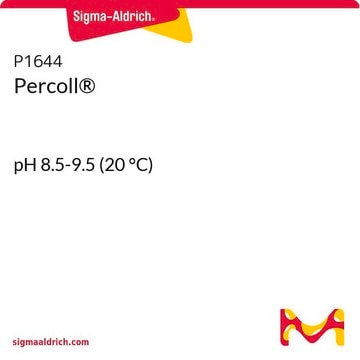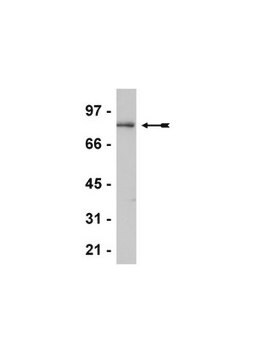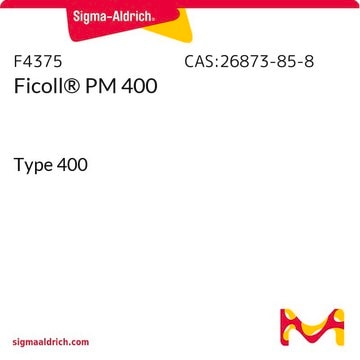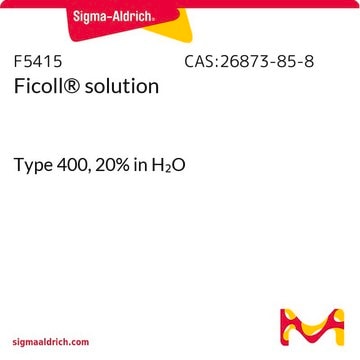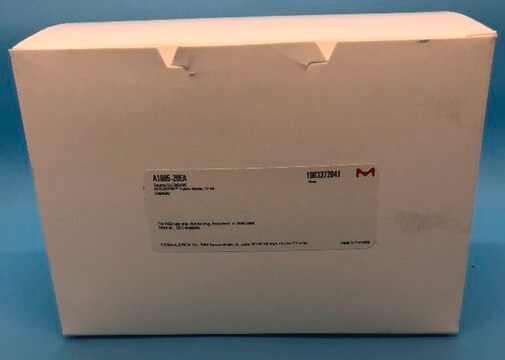10771
Histopaque®-1077
sterile-filtered, density: 1.077 g/mL
Sign Into View Organizational & Contract Pricing
All Photos(3)
About This Item
UNSPSC Code:
12352207
NACRES:
NA.75
Recommended Products
sterility
sterile-filtered
form
liquid
shelf life
Expiry date on the label.
impurities
endotoxin, tested
density
1.077 g/mL
application(s)
hematology
histology
storage temp.
2-8°C
General description
Histopaque-1077 is a sterile, endotoxin tested, ready-to-use medium. The Histopaque composition includes polysucrose and sodium diatrizoate, adjusted to a density of 1.077g/mL. This ready-to-use medium facilitates rapid recovery of viable lymphocytes and other mononuclear cells from small volumes of whole blood or bone marrow.
Application
Histopaque-1077 has been used for:
- human lymphocyte antigen (HLA) typing
- initial isolation step prior to the enumeration of T, B, and ‘null’ lymphocytes.
- preparation of pure lymphocyte suspensions for cell culture and cytotoxicity assays.
- isolation and purification of peripheral blood mononuclear cells (PBMCs) and bone marrow mononuclear cells (BMMCs)
- isolation of human lymphocytes
- isolation of breast cancer circulating tumor cells (CTCs) from the whole blood
- Histopaque-1077 is used in conjunction with Histopaque-1119 as it facilitates the rapid recovery of viable mononuclear cells and granulocytes from small volumes of whole blood
Features and Benefits
Histopaque®-1077 offers numerous advantages, such as:
- Optimal recovery of viable cells
- Permits selective separation of blood cell types
- Prevents cell distortion
- Preserves cell viability
- Minimal extraneous cell interference
- Reproducible performance from batch to batch
- Sterile-filtered and endotoxin-tested
- Stable at 2-8°C for at least 2 years when protected from light
Principle
Anticoagulated blood is layered onto Histopaque-1077. During centrifugation, erythrocytes are aggregated by polysucrose and rapidly sediment. Granulocytes become slightly hypertonic, which increases their sedimentation rate, resulting in pelleting at the bottom of the centrifuge tube. Lymphocytes and other mononuclear cells remain at the plasma/ Histopaque-1077 interface.
Legal Information
Histopaque is a registered trademark of Merck KGaA, Darmstadt, Germany
also commonly purchased with this product
Product No.
Description
Pricing
recommended
related product
Product No.
Description
Pricing
Signal Word
Danger
Hazard Statements
Precautionary Statements
Hazard Classifications
Resp. Sens. 1 - Skin Sens. 1
Storage Class Code
12 - Non Combustible Liquids
WGK
WGK 3
Certificates of Analysis (COA)
Search for Certificates of Analysis (COA) by entering the products Lot/Batch Number. Lot and Batch Numbers can be found on a product’s label following the words ‘Lot’ or ‘Batch’.
Already Own This Product?
Find documentation for the products that you have recently purchased in the Document Library.
Customers Also Viewed
Evaluation of respiration with clark type electrode in isolated mitochondria and permeabilized animal cells.
Silva AM and Oliveira PJ
Methods in Molecular Biology, 810, 7-24 (2012)
Erin E Thacker et al.
Vaccine, 27(50), 7116-7124 (2009-09-30)
Targeting viral vectors encoding tumor-associated antigens to dendritic cells (DCs) in vivo is likely to enhance the effectiveness of immunotherapeutic cancer vaccines. We have previously shown that genetic modification of adenovirus (Ad) 5 to incorporate CD40 ligand (CD40L) rather than
Romain A Colas et al.
Journal of immunology (Baltimore, Md. : 1950), 197(11), 4444-4452 (2016-11-02)
Maresin 1 (MaR1) is an immunoresolvent that governs resolution of acute inflammation, and its local metabolism in the context of infectious inflammation is of interest. In this study, we investigated the MaR1 metabolome in infectious exudates and its bioactions in
Maria Björkqvist et al.
The Journal of experimental medicine, 205(8), 1869-1877 (2008-07-16)
Huntington's disease (HD) is an inherited neurodegenerative disorder characterized by both neurological and systemic abnormalities. We examined the peripheral immune system and found widespread evidence of innate immune activation detectable in plasma throughout the course of HD. Interleukin 6 levels
Ana C Leal et al.
Scientific reports, 7(1), 6438-6438 (2017-07-27)
Cancer patients are at an increased risk of developing thromboembolic complications. Several mechanisms have been proposed to explain cancer-associated thrombosis including the release of tumor-derived extracellular vesicles and the activation of host vascular cells. It was proposed that neutrophil extracellular
Our team of scientists has experience in all areas of research including Life Science, Material Science, Chemical Synthesis, Chromatography, Analytical and many others.
Contact Technical Service


